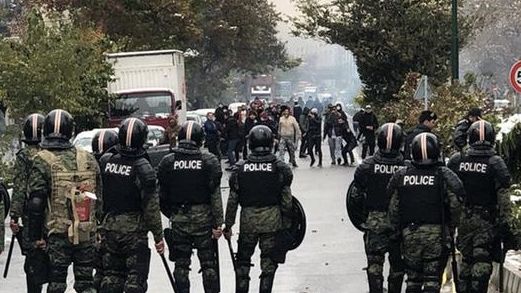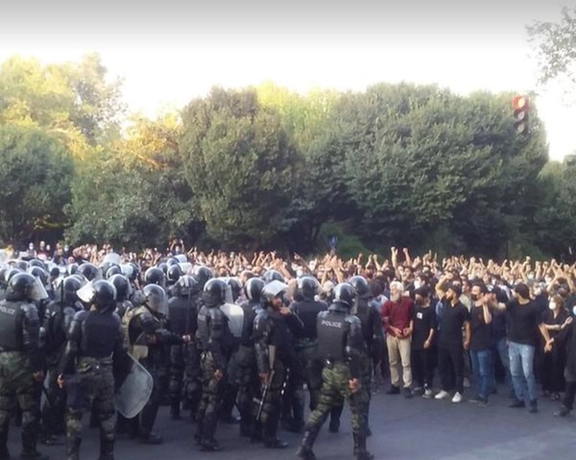Four Years After Bloody Protests, Iran's Stability Remains Elusive

Candles, vigils, sobbing and lamenting mothers, and offerings of traditional food and snacks at cemeteries on colorful tablecloths are common scenes in Iran this week.

Candles, vigils, sobbing and lamenting mothers, and offerings of traditional food and snacks at cemeteries on colorful tablecloths are common scenes in Iran this week.
Families of victims and ordinary people mark the 4th anniversary of the killing of at least 1,500 mostly young protesters in less than five days in November 2019.
Photos of fallen protesters are circulating widely on social media, with users posting collages of hundreds of images of young men and women who lost their lives in one of Iran's bloodiest crackdowns on dissent under the Islamic rule.
Days of intense nationwide protests, triggered by a sudden government decision to raise fuel prices, started on November 14, 2019, and marked the beginning of prolonged periods of dissent. What made the people angry was not simply a price rise. It was the painful humiliation they felt as the government did not bother to let them know in advance about the hike. In addition, when the media reported about a possible price rise, government officials denied any such plans.
The announcement came at midnight, presumably to minimize public shock. However, the morning revealed an even greater shock, as prices had tripled overnight. Iranians, anticipating a ripple effect on other prices, took to the streets in unprecedented numbers.

As many, including Iranian journalist Shahed Alvai have observed, "the crackdown was even more unprecedented. Protests took place in 104 Iranian cities in 29 provinces, and they were quickly turned into a massive anti-regime movement. Protesters ruled out reconciliation with the government and took to the streets in a scale that terrified the government."
The Revolutionary Guard’s paramilitary forces, the Basij, that was deployed to suppress the demonstrations labeled the 2019 protests as "An all-out war against the regime and the Islamic revolution." The regime's response was ruthless massacre, a method it continued to employ in subsequent nationwide protests, including those sparked by public anger with the Morality Police, after the death of 22-year-old Mahsa Amini after her arrest for “improper hijab” in September 2022.
During the 2019 protests in the month of Aban on the Iranian calendar (October 22 to November 21), protesters, for the first time, chanted slogans against the entire regime: "We do not want the reformists and conservatives. That is all over!" They were referring to two insider factions ruling Iran for three decades. The government recognized the severity of the threat, leading to a violent crackdown on dissent, and in the words of Iranian dissidents, "Aban continued."
Four years later, references to Aban are abundant. People are still remembering and mourning the fallen protesters who were often shot at point blank range as documented by International human rights organizations. The victims' families are still being harassed by security forces and sometimes imprisoned for several years.
In subsequent protests, the government, mindful of the international backlash to the large number of protester deaths, took pride in claiming fewer casualties in 2022. However, shotguns replaced rifles, resulting in many being wounded or blinded, and a higher number ended up in jail.
What the ruling elite did not learn was addressing the root cause of dissent: Deteriorating economic conditions in 2019 and serious political issues including demands for civil liberties and respect for human rights in 2022. Only after the nationwide protests in 2022 did government officials express a willingness to engage in dialogue with the people. However, once the streets calmed, they abandoned the call for reconciliation, adopting a rude and humiliating tone toward Iranians, particularly women, teachers, university professors, workers, and pensioners, on a daily basis.
Reformist commentator Abbas Abdi reminded the government in a commentary in Etemad newspaper that, during the 2022 protests, they used to be humble and call for dialogue with protesters. However, as soon as they believed the protests were behind them, they returned to their factory settings, speaking arrogantly.
According to Abdi, authorities interviewed 66 scholars, including himself, to understand the events and reasons behind the protests. However, he criticized the government's reluctance, stating, “As far as they are concerned, there was a security problem, and the security forces sorted it out." Abdi acknowledged that "The way the government is handling last year's protests has not changed."
Despite government assertions, numerous social media posts by political activists, often writing under an alias, insist that the Bloody Aban is not over. As Alavi pointed out, "The names, memories, and pictures of Aban 2019 live on as family members of fallen protesters keep them alive. Eyewitnesses are in prisons, and family members have not stopped seeking justice." Mahboubeh Ramezani, the mother of Pejman Gholipour, one of the young men killed in November 2019, has told the government: "You know that Aban has destroyed you and that Aban still goes on."